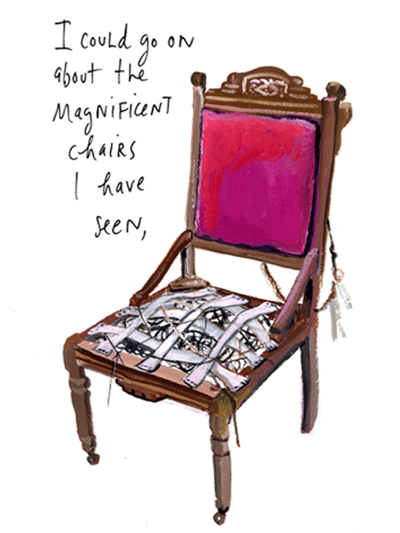 Oh, I'm sure I've blogged about her before but after spending this sunny Sunday morning curled up with a cup of coffee in a perky orange mug and a copy of Kalman's The Principles of Uncertainty, it all seemed worth repeating, worth expanding upon, worth gushing about.
Oh, I'm sure I've blogged about her before but after spending this sunny Sunday morning curled up with a cup of coffee in a perky orange mug and a copy of Kalman's The Principles of Uncertainty, it all seemed worth repeating, worth expanding upon, worth gushing about.
I confess that I don't recall exactly how I first heard about Maira Kalman -- illustrator, painter, author, thinker-of-things, collector-of-stuff -- but I think it was when I stumbled upon a copy of her Max the dog (and poet! and dreamer!) childrens books in a sale bin. This seems odd to me in retrospect because I don't generally read childrens books; I'm not one of those grown-ups. But there was something about the whimsical but sophisticated style of her drawings that grabbed me -- no doubt because I recognized it, subconsciously at least, from her numerous New Yorker covers. Not to mention the fact that the storylines and the copy are so sweet, so crazy and namecheck a zillion philosophers, musicians, poets, painters and writers and other folk you don't normally find in the pages of childrens books.
But I realize the telling of the beginning of our love story is boring. Suffice it to say I have continued to cultivate a love for all things Kalman, including her illustrated edition of the classic grammar book The Elements of Style (which was given to me by my friend Margaret who didn't even KNOW how much I loved Maira Kalman!!!). I ogle online the textile designs she has produced for Kate Spade and Isaac Mizrahi. I fantasize about owning a print of one of her New Yorker covers.
Right now, as I said, I'm really enjoying reading The Principles of Uncertainty, an illustrated collection of writings that detail a year inside her kooky, sad and beautiful mind. (The writings originally appeared as a New York Times blog and you can still read them online if you don't want to own the book and hug it to you frequently.) There is, I think, living in equal measure with her kookiness, a real sense of sadness and conflict in Kalman's observations about life. There's a wistfulness and a melancholy that coexist with the joy of small, beautiful things and a deep-seated sense of gratitude.
To wit, one of my favorite pages from the book:
Isn't that just beautiful and sad and true?
If I haven't overwhelmed you with all things Kalman by now, you might also want to check out this terrific interview with her over at Media Bistro, conducted following the release of The Elements of Style. A couple of gems from it, if you're uninclined to read the whole thing:
Regarding the comparison of the writing and painting processes:
"I try to paint in a narrative way and I write in a painterly way. I don't' know if one is harder…I think there are different difficulties—no, there's always the same difficulty in finding your voice in whatever you're doing, and being both inspired and natural at the same time, and traveling the lines of extremes, being smart and stupid and happy and tragic."
I love that last part: smart and stupid and happy and tragic. What a goal to strive for in painting and in writing and in life, no?
Also, regarding breaking rules in the creative process (a response which I think applies to all expressions of creativity):
"Well, you can decide what your definition of a rule is, but I think there has to be a moment in the process where you make a leap outside of what is expected. There can't be an original piece of work that isn't conceived outside of some constraint. Even if you're bound to grammar, you're doing something within that context that's inventive or experimental. That's how things change and things progress, and that's why we have new things and things that are inspired. I think it's learning how to have fun, or the sense of play—it's thrilling to be able to do that. And also for the reader, or for the person who's looking at a painting, that there's some kind of fresh spark that's set off in you, how to tell your story in your own way. And not everyone wants to do that or needs to do that."
I think that second line is fascinating: "There can't be an original piece of work that isn't conceived outside of some constraint."
Sigh. So much to think about in this world, isn't there? I'm so grateful that Maira Kalman is out there noticing things, thinking about them and then writing and/or drawing about it. (I also hope that I don't get the pants sued off me for publishing, without permission, the two illustrations above, which I nicked from the New York Times website. I'll just say I conceived the idea outside of their restraint and see where it gets me.)
